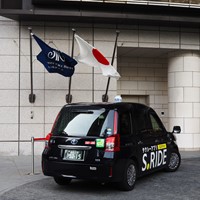Catching A Taxi in Japan

As convenient as the train system is, there are still times when you will need to take a taxi in Japan. While taking a taxi long distances will still cost you a lot more than other forms of public transport in Japan, you can almost be assured of a comfortable and safe experience with a smartly dressed driver and clean car. Here we will explain how to catch a taxi in Japan, including some basic facts about the Japan taxi system that are handy to keep in mind before you catch one.
We also have many articles covering transportation in Japan including train etiquette, using the bus, renting a car, and more.
How to Take a Taxi in Japan
Catching a taxi in Japan is usually quite a simple and civil affair. You either wait for one at a taxi stand, book via a smartphone app or phone, or simply hail taxi off the street.
1. Find a Taxi Stand

One of the easiest options is to go to a taxi stand. You can expect to find them near high foot-traffic areas such as train stations and of course at big hotels, where more often than not a long row of taxis will be lining up for passengers. Although you may be tempted to hop into the taxi which happens to be closest to you, please do not. Japanese taxi etiquette dictates that you ride the one at the front of any given line—even if you’re alone!
2. Book a Taxi

The next option is to book a taxi via telephone or app. In Japan, there are many apps that you can you use to reserve a taxi: "Taxi Apps in Japan: Your Gateway to Seamless Urban Mobility". If you would like to book a taxi in Tokyo, please check this article.
3. Catch a Taxi On the Street

The other option is to simply catch a taxi on the street. Go to the nearest main street and look for a taxi with the word 空車 (ku-sha) such as below, which means “available”. Even if you cannot remember the Japanese, do try to keep in mind that “available” signs for taxis in all over Japan are red.

While there are many types of taxis, you will mostly see sedan and JPN Taxis running on the streets in Japan.
| Sedan Type Taxi | JPN Taxi |
 |
 |
Hail a taxi by stepping to the edge of the street, look intently at the driver, wave or raise a hand to get the taxi driver's attention.

When a Japanese taxi driver stops to pick you up, he will almost always put on his hazard lights as he pulls over to the side of the road. Don’t bother reaching out to open the backseat door–this is controlled by the driver and it will swing open automatically for you. No smoking is allowed within the taxis. If you would like to consume food within the taxi, it would be polite to ask even though the driver will usually give their consent.
Taxi Marquee Signs
Below is an explanation of all of the typical signs you will see on a Taxi marquee. These signs are basically the same throughout Japan in general.
1) Warimashi

Increased Night Fare – Between the hours of 10 pm-5 am, taxis charge an additional 20% fare so you will see this sign on many taxis available during that timeframe.
2) Chinsou

Not available
3) Kaisou

Out of service
4) Kashikiri / Geisha


Reserved, on the way to a pick-up
5) Yoyakusha

Reserved for specific amount of time
Japanese Taxi Words and Phrases for Getting to Your Destination
Don’t rely on a taxi drivers’ knowledge of English to get you where you want to go. If you haven’t been to your destination before and can’t give the driver directions in Japanese, it’s a good idea to have the address at hand for the driver to input into the taxi’s GPS system. A note with the address in Japanese, a physical map, a screen capture, or the website of your destination are all preferable to verbal confirmation only. That said, you will probably need to say a few things during your trip. If you would like to try to use one of the Japanese voice translator/interpreter apps, please check this article.
Below is a hypothetical dialogue between a driver and passenger, illustrating how you might communicate. There is also a list of common words you will need to know when instructing a taxi driver where to drop you off. Japanese follows English in each sentence.
Explaining your destination
Driver: “Where would you like to go?”
Dochira made?
You: “Please take me to Roppongi 3-chome”
Roppongi san-chome made onegai shimasu.
Driver: “Certainly.”
Kashikomarimashita.
Giving directions
"Please turn left (right) at the next corner.
Tsugi no kado wo hidari (migi) ni magatte kudasai.
"Please stop just before the traffic lights."
Shingou no temae de tomete kudasai.
"My apartment (house) is right on the next corner."
Watashi no apato (ie) wa tsugi no kado desu.
"Please stop here."
Koko de tomete kudasai.
"How much?"
Ikura desuka?
"Please give me a receipt."
Ryoshusho wo kudasai / Reshiito wo kudasai.
Tip: It is advisable to receive a receipt as you can find the taxi company's contact information on it. It is very useful in case you lost something in a taxi. To learn how to find lost items in Japan, please check this article.
Common words
| Right: Migi | Left: Hidari |
| Straight: Massugu | Turn: Magaru |
| Stop: Tomaru | Here: Koko |
| There: Asoko | This: Kore |
| That: Are | It: Sore |
| I’m in a hurry: Isoide imasu | Please drive faster: Isoide kudasai |
We also have many articles that will help you with learning Japanese language.
Take a Taxi in Japan

Taking a taxi in Japan is a wonderful option, especially when it comes to clean, simple and convenient intra-city public transport that doesn’t care what time it is. So the next time you’ve missed your train, are looking to pamper your feet a little or have a lot of luggage to carry, don’t hesitate to call or hail a taxi!





















